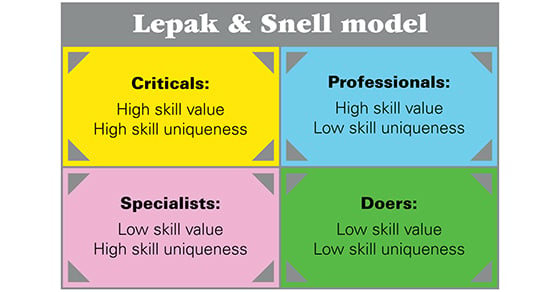 Every year, when baseball season finally ends, a most valuable player (MVP) is named in each league. Not everyone agrees on the choice; in fact, it’s something fans love to argue about. But eventually the two players receive their awards and their names go into the record books.
Every year, when baseball season finally ends, a most valuable player (MVP) is named in each league. Not everyone agrees on the choice; in fact, it’s something fans love to argue about. But eventually the two players receive their awards and their names go into the record books.
Can you name your organization’s MVPs? (You probably have far more than one or two.) A common assumption is that the highest-paid person in each department is the most valuable. But this isn’t always the case. Identifying your true MVPs can help you make optimal employment decisions ranging from hiring to retention to compensation.
Identifying the highly skilled
One insightful framework for taking a fresh look at your workforce is the Lepak & Snell model. It’s a four-quadrant, skills-based paradigm dividing employees by value of skills particular to your organization and the skills’ uniqueness in the labor market. Each employee’s skills will fall into one of four quadrants:
• High value, high uniqueness,
• High value, low uniqueness,
• Low value, high uniqueness, and
• Low value, low uniqueness.
Assess where your employees’ skills fall on the value spectrum based on criteria most pertinent to your mission, such as the ability to:
• Lower costs,
• Increase revenue,
• Strengthen customer relationships,
• Foster team collaboration,
• Offer creative ideas, and
• Solve problems.
The uniqueness spectrum depicts the degree to which employees’ skills are narrowly applicable to your organization, and, thus, harder to find in the labor market. Let’s say you produce a distinctive, expensive and complex product. It takes years for employees involved in the production to develop the necessary talent. Those employees will be rated highly on the uniqueness spectrum. The same principle is applicable to specialized services.
Looking at organizational structure
The purpose of the framework isn’t solely to categorize your current employees. It’s also helpful in organizing your workforce structure by job function. You can create a generic organizational chart by department or by division and assign job titles and functions to the four quadrants.
For example, a sales manager position might require an employee who qualifies as a critical employee. But you’ll likely need employees representing all four quadrants in most if not all departments.
After you’ve applied the Lepak & Snell model to your organizational chart, look for inconsistencies. Are some departments understaffed in terms of skill? Overstaffed? If so, why? Is any action warranted, either in the short or long term?
Above all, identify your criticals. Putting these employees at the top of your retention priority list makes sense, as does looking to hire — or train — more highly skilled workers like them. They are your MVPs.
Analyzing and quantifying
The Lepak & Snell model may not be the “be all, end all” to understanding your workforce. But it, if nothing else, can provide a fresh view of it. Our firm can provide more information on ways to analyze and quantify the value of your employees.
For more information on the above article or any human resource management services, please contact Amber Malik at (334) 321-4729 or by leaving us a message below.







